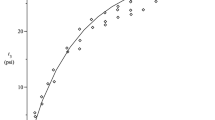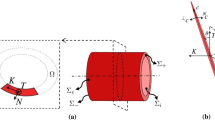Abstract
A micromechanical analysis is offered for the prediction of the global behavior of biological tissues. The analysis is based on the isotropic–hyperelastic behavior of the individual constituents (Collagen and Elastin), their volume fractions, and takes into account their detailed interactions. The present analysis predicts the instantaneous tensors from which the effective current first tangent tensor is established, thus providing the overall anisotropic constitutive behavior of the composite and the resulting field distribution in the composite. This is in contradistinction with the macroanalysis in which the composite internal energy, which involves unknown functions that depend on several strain invariants, must be proposed. The offered micromechanical analysis forms a generalization to the finite strain high-fidelity generalized method of cells (HFGMC) based on the homogenization technique for periodic composites to the parametric finite strain. This involves an arbitrary discretization of the repeating unit-cell of the periodic composites. Results are given for the response of the human abdominal aorta, which consists of three layered tissues: intima, media, and adventitia, all of which are composed out of the Collagen and Elastin. The isotropic–hyperelastic constituents (Mooney–Rivlin and Yeoh) of the composites are calibrated by utilizing available experimental data which describe the response of the tissue. Validation of the results is performed by comparison of the predicted Cauchy stress and stretches with the experimental measurements. In addition, results are given in the form of Cauchy stress and deformation gradient field distributions in the constituents of several tissues.






Similar content being viewed by others
References
Aboudi J (2009) Finite strain micromechanical analysis of rubber-like matrix composites incorporating the Mullins damage effect. Int J Damage Mech 18(1):5–29
Aboudi J, Arnold SM, Bednarcyk BA (2013) Micromechanics of composite materials: a generalized multiscale approach. Elsevier, New York
Aboudi J, Volokh KY (2015) Failure prediction of unidirectional composites undergoing large deformations. J Appl Mech 82(7):71004
Barnes CP, Sell SA, Boland ED, Simpson DG, Bowlin GL (2007) Nanofiber technology: designing the next generation of tissue engineering scaffolds. Adv Drug Deliv Rev 59(14):1413–1433
Carniel TA, Klahr B, Fancello EA (2018) A multiscale numerical approach for the finite strains analysis of materials reinforced with helical fibers. Mech Mater 126:75–85
Carniel TA, Klahr B, Fancello EA (2019) On multiscale boundary conditions in the computational homogenization of an rve of tendon fascicles. J Mech Behav Biomed Mater 91:131–138
Caves JM, Cui W, Wen J, Kumar VA, Haller CA, Chaikof EL (2011) Elastin-like protein matrix reinforced with collagen microfibers for soft tissue repair. Biomaterials 32(23):5371–5379
Chen H, Guo X, Luo T, Kassab GS (2016) A validated 3d microstructure-based constitutive model of coronary artery adventitia. J Appl Physiol 121(1):333–342
Chen H, Kassab GS (2016) Microstructure-based biomechanics of coronary arteries in health and disease. J Biomech 49(12):2548–2559
Frank MBO, Niestrawska JA, Holzapfel GA, de Botton G (2019) Micromechanically-motivated analysis of fibrous tissue. J Mech Behav Biomed Mater 96:69–78
Garcia-Gonzalez D, Jérusalem A, Garzon-Hernandez S, Zaera R, Arias A (2018) A continuum mechanics constitutive framework for transverse isotropic soft tissues. J Mech Phys Solids 112:209–224
Gilat R, Aboudi J (2008) Postbuckling of layered composites by finite strain micromechanical analysis. Multisc Comput Eng 6(5):469–481
Hackett RM (2016) Hyperelasticity primer. Springer, Heidelberg
Haj-Ali R, Aboudi J (2013) A new and general formulation of the parametric HFGMC micromechanical method for two and three-dimensional multi-phase composites. Int J Solids Struct 50(6):907–919
Haj-Ali R, Aboudi J (2018) The parametric HFGMC micromechanics. In: Micromechanics and nanomechanics of composite solids, Springer, Cham, pp 391–424
Holzapfel GA (2000) Nonlinear solid mechanics: a continuum approach for engineering science. Wiley, Chichester
Holzapfel GA (2006) Determination of material models for arterial walls from uniaxial extension tests and histological structure. J Theor Biol 238(2):290–302
Holzapfel GA, Gasser TC, Ogden RW (2000) A new constitutive framework for arterial wall mechanics and a comparative study of material models. J Elast 61(1–3):1–48
Holzapfel GA, Weizsäcker HW (1998) Biomechanical behavior of the arterial wall and its numerical characterization. Comput Biol Med 28(4):377–392
Humphrey JD (2013) Cardiovascular solid mechanics: cells, tissues, and organs. Springer, Berlin
Javili A, Steinmann P, Mosler J (2017) Micro-to-macro transition accounting for general imperfect interfaces. Comput Methods Appl Mech Eng 317:274–317
Jha NK, Reinoso J, Dehghani H, Merodio J (2018) A computational model for fiber-reinforced composites: hyperelastic constitutive formulation including residual stresses and damage. Comput Mech
Klisch SM, Lotz JC (1999) Application of a fiber-reinforced continuum theory to multiple deformations of the annulus fibrosus. J Biomech 32(10):1027–1036
Malvern LE (1969) Introduction to the mechanics of a continuous medium. Number Monogr
Matthews JA, Wnek GE, Simpson DG, Bowlin GL (2002) Electrospinning of collagen nanofibers. Biomacromolecules 3(2):232–238
Miranda-Nieves D, Chaikof EL (2016) Collagen and elastin biomaterials for the fabrication of engineered living tissues. ACS Biomater Sci Eng 3(5):694–711
Niestrawska JA, Viertler C, Regitnig P, Cohnert TU, Sommer G, Holzapfel GA (2016) Microstructure and mechanics of healthy and aneurysmatic abdominal aortas: experimental analysis and modelling. J R Soc Interface 13(124):20160620
Nolan DR, Gower AL, Destrade M, Ogden RW, McGarry JP (2014) A robust anisotropic hyperelastic formulation for the modelling of soft tissue. J Mech Behav Biomed Mater 39:48–60
Peña JA, Corral V, Martinez MA, Pena E (2018) Over length quantification of the multiaxial mechanical properties of the ascending, descending and abdominal aorta using digital image correlation. J Mech Behav Biomed Mater 77:434–445
Peña JA, Martínez MA, Peña E (2019) Failure damage mechanical properties of thoracic and abdominal porcine aorta layers and related constitutive modeling: phenomenological and microstructural approach. Biomech Model Mechanobiol 1–22
Pierce DM, Maier F, Weisbecker H, Viertler C, Verbrugghe P, Famaey N, Fourneau I, Herijgers P, Holzapfel GA (2015) Human thoracic and abdominal aortic aneurysmal tissues: damage experiments, statistical analysis and constitutive modeling. J Mech Behav Biomed Mater 41:92–107
Saeb S, Steinmann P, Javili A (2016) Aspects of computational homogenization at finite deformations: a unifying review from reuss’ to voigt’s bound. Appl Mech Rev 68(5):050801
Sell SA, McClure MJ, Garg K, Wolfe PS, Bowlin GL (2009) Electrospinning of collagen/biopolymers for regenerative medicine and cardiovascular tissue engineering. Adv Drug Deliv Rev 61(12):1007–1019
Sharabi M, Benayahu D, Benayahu Y, Isaacs J, Haj-Ali R (2015) Laminated collagen-fiber bio-composites for soft-tissue bio-mimetics. Compos Sci Technol 117:268–276
Sharabi M, Varssano D, Eliasy R, Benayahu Y, Benayahu D, Haj-Ali R (2016) Mechanical flexure behavior of bio-inspired collagen-reinforced thin composites. Compos Struct 153:392–400
Sodhani D, Reese S, Jockenhoevel S, Mela P, Stapleton SE (2018) Multi-scale modelling and simulation of a highly deformable embedded biomedical textile mesh composite. Compos Part B Eng 143:113–131
Tsamis A, Krawiec JT, Vorp DA (2013) Elastin and collagen fibre microstructure of the human aorta in ageing and disease: a review. J R Soc Interface 10(83):20121004
Weiss JA, Maker BN, Govindjee S (1996) Finite element implementation of incompressible, transversely isotropic hyperelasticity. Comput Methods Appl Mech Eng 135(1–2):107–128
Zeinali-Davarani S, Wang Y, Chow M-J, Turcotte R, Zhang Y (2015) Contribution of collagen fiber undulation to regional biomechanical properties along porcine thoracic aorta. J Biomech Eng 137(5):051001
Acknowledgements
This research was supported by the Israel Science Foundation (ISF) (Grant No. 2314/19). The last author gratefully acknowledges the support of the Nathan Cummings Chair in Mechanics.
Author information
Authors and Affiliations
Corresponding author
Ethics declarations
Conflict of interest
The authors declare that they have no conflict of interest.
Additional information
Publisher's Note
Springer Nature remains neutral with regard to jurisdictional claims in published maps and institutional affiliations.
Rights and permissions
About this article
Cite this article
Breiman, U., Meshi, I., Aboudi, J. et al. Finite strain parametric HFGMC micromechanics of soft tissues. Biomech Model Mechanobiol 19, 2443–2453 (2020). https://doi.org/10.1007/s10237-020-01348-x
Received:
Accepted:
Published:
Issue Date:
DOI: https://doi.org/10.1007/s10237-020-01348-x




